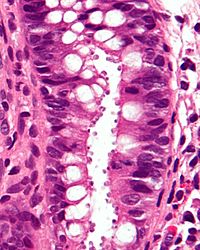
Photo from wikipedia
Purpose. Conventional laboratory detection methods for gastrointestinal parasites are time consuming, require considerable technical expertise and may suffer from poor analytical sensitivity. This study sought to evaluate the automated BD… Click to show full abstract
Purpose. Conventional laboratory detection methods for gastrointestinal parasites are time consuming, require considerable technical expertise and may suffer from poor analytical sensitivity. This study sought to evaluate the automated BD MAX Enteric Parasite Panel (EPP) for the detection of Cryptosporidium parvum/hominis, Entamoeba histolytica and Giardia duodenalis. Methodolgy. A total of 104 known positive samples (43 Cryptosporidium parvum/hominis and 61 G. duodenalis), 15 simulated samples (E. histolytica and other Entamoeba species) and 745 patient stool samples, submitted for enteric pathogen culture and microscopy, were inoculated into BD MAX EPP sample buffer tubes (SBTs). All specimens were blinded and tested within 7 days of SBT inoculation using the BD MAX EPP assay with results compared to those generated by microscopy. Results/Key findings. Combining the results from the known positive samples and anonymously tested patient samples, the sensitivity of the BD MAX EPP assay was 100% for both Cryptosporidium spp. and G. duodenalis. Specificities of 99.7 and 98.9% were calculated for the detection of Cryptosporidium spp. and G. duodenalis respectively. Insufficient clinical specimen data was available to determine the performance of the assay for E. histolytica detection. Conclusions. The findings of this study indicate that the BD MAX EPP is suitable for the detection of Cryptosporidium parvum/hominis and G. duodenalis from clinical specimens with reduced hands‐on time and complexity compared to microscopy. Results for the detection of E. histolytica were promising although further work is required to evaluate the assay for the detection of this pathogen.
Journal Title: Journal of Medical Microbiology
Year Published: 2017
Link to full text (if available)
Share on Social Media: Sign Up to like & get
recommendations!